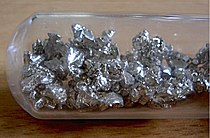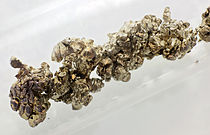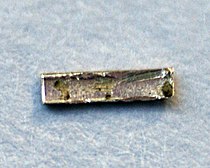| Alkaline earth metals | |||||||||||
|---|---|---|---|---|---|---|---|---|---|---|---|
| |||||||||||
| ↓ Period | |||||||||||
| 2 | Beryllium (Be) 4 | ||||||||||
| 3 | Magnesium (Mg) 12 | ||||||||||
| 4 | Calcium (Ca) 20 | ||||||||||
| 5 | Strontium (Sr) 38 | ||||||||||
| 6 | Barium (Ba) 56 | ||||||||||
| 7 | Radium (Ra) 88 | ||||||||||
|
Legend
| |||||||||||
The alkaline earth metals are six chemical elements in group 2 of the periodic table. They are beryllium (Be), magnesium (Mg), calcium (Ca), strontium (Sr), barium (Ba), and radium (Ra).[1] The elements have very similar properties: they are all shiny, silvery-white, somewhat reactive metals at standard temperature and pressure.[2]
Together with helium, these elements have in common an outer s orbital which is full[2][3][4]—that is, this orbital contains its full complement of two electrons, which the alkaline earth metals readily lose to form cations with charge +2, and an oxidation state of +2.[5] Helium is grouped with the noble gases and not with the alkaline earth metals, but it is theorized to have some similarities to beryllium when forced into bonding and has sometimes been suggested to belong to group 2.[6][7][8]
All the discovered alkaline earth metals occur in nature, although radium occurs only through the decay chain of uranium and thorium and not as a primordial element.[9] There have been experiments, all unsuccessful, to try to synthesize element 120, the next potential member of the group.
- ^ International Union of Pure and Applied Chemistry (2005). Nomenclature of Inorganic Chemistry (IUPAC Recommendations 2005). Cambridge (UK): RSC–IUPAC. ISBN 0-85404-438-8. pp. 51. Electronic version..
- ^ a b Royal Society of Chemistry. "Visual Elements: Group 2–The Alkaline Earth Metals". Visual Elements. Royal Society of Chemistry. Archived from the original on 5 October 2011. Retrieved 13 January 2012.
- ^ "Periodic Table: Atomic Properties of the Elements" (PDF). nist.gov. National Institute of Standards and Technology. September 2010. Archived (PDF) from the original on 2012-08-09. Retrieved 17 February 2012.
- ^ Lide, D. R., ed. (2003). CRC Handbook of Chemistry and Physics (84th ed.). Boca Raton, FL: CRC Press.
- ^ Greenwood, Norman N.; Earnshaw, Alan (1997). Chemistry of the Elements (2nd ed.). Butterworth-Heinemann. ISBN 978-0-08-037941-8.
- ^ Grochala, Wojciech (1 November 2017). "On the position of helium and neon in the Periodic Table of Elements". Foundations of Chemistry. 20 (2018): 191–207. doi:10.1007/s10698-017-9302-7.
- ^ Bent Weberg, Libby (18 January 2019). ""The" periodic table". Chemical & Engineering News. 97 (3). Archived from the original on 1 February 2020. Retrieved 27 March 2020.
- ^ Grandinetti, Felice (23 April 2013). "Neon behind the signs". Nature Chemistry. 5 (2013): 438. Bibcode:2013NatCh...5..438G. doi:10.1038/nchem.1631. PMID 23609097.
- ^ "Abundance in Earth's Crust". WebElements.com. Archived from the original on 9 March 2007. Retrieved 14 April 2007.





